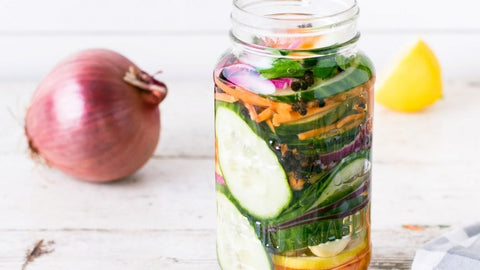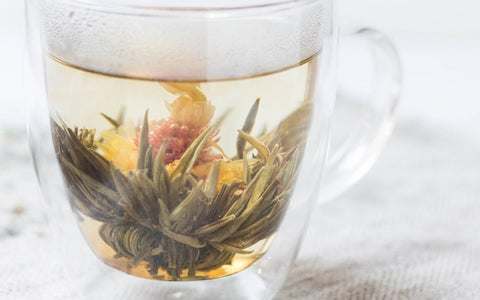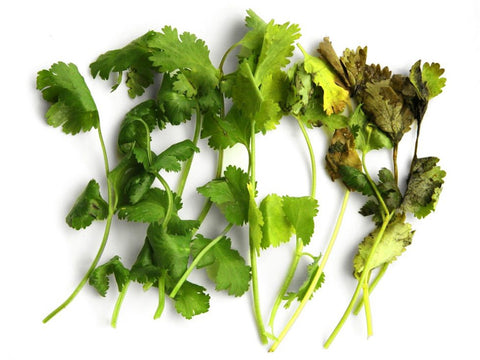We talk a lot here at Urban Leaf about growing your own herbs and veggies so that you have fresh basil, dill, tomatoes, peppers, etc. to add to your favorite recipes. But fresh herbs aren’t the ONLY option! We recently learned a lot about pickling and preserving fresh produce as a sustainable (and delicious) food storage option, as well as a way to get added nutrients to your diet. Pickling, canning, and preserving things like tomatoes, peppers, green peas, and even zucchini or beets is a great way to use your herbs to adjust the flavor profile of these stored foods and branch out of your typical mealtime routine!
We chatted with the two humans behind The Real Dill, whose happy hobby of making pickles turned into a full-fledged business. They gave us some insight into pickling and canning along with some recipes for you to try out yourself.

What is the Difference Between Canning and Pickling?
First, let’s understand some key terms. Canning and pickling are NOT the same. The main difference is that pickling implies acidifying the contents using vinegar or another form of acid. This also means it undergoes a fermentation process, creating incredible benefits for your gut (i.e., probiotics, necessary for your immune health!).
Pickling is the process of converting fresh produce (usually vegetables) to pickles using a solution of vinegar, water, salt, and sometimes sugar, along with herbs or spices. Heat the liquid, pour it over the sliced/diced/chopped veggies in hot sterile jars, and refrigerate. Note that not all pickling results in fermentation. To make lacto-fermented pickles, a different process is required, which doesn’t result in a shelf-stable product.
Canning is a method of preserving food by processing (usually by submerging it in boiling water) and sealing it in an airtight container. It uses heat to sterilize bacteria, allowing food storage for up to 5 years without refrigeration. The two common methods are the “Water Bath” and “Pressure” methods. Learn more about these methods through further research.

The team at The Real Dill mentioned that you can “pickle” almost anything, not just cucumbers. Water-dense vegetables like celery, beets, carrots, cucumbers, peppers, green beans, okra, and onions hold up best. More tender vegetables won’t retain a crunchy texture.
Some of these vegetables are available in our Vegetable Seed 3-Packs, and we also provide seeds for one of the secret ingredients to pickling and canning – fresh herbs! The Real Dill team loves to add fresh herbs to bring a unique flavor to their pickles. Typically, you add them while packing the jar, before adding your brine. Dill is the obvious choice for classic dill pickles, but for other pickling recipes, try parsley or basil for different flavors. These would be delicious in pickled carrots, beets, or cabbage. Grab all three at once in our Culinary Classics Bottle Garden Kit. Also, check out this recipe for Dill and Swiss Fritters, which would pair well with your homemade dill pickle.

How to Sterilize Your Pickling Jars
One question that came up while chatting with The Real Dill was about sterilizing pickling jars, especially if you aim to reuse them. To sterilize your jars, either wash them in the dishwasher or use soap and water. It’s also recommended to dip the lids in boiling water to sterilize them. Pretty simple.

What Kinds of Vegetables Can I Pickle?
There’s no wrong way to pickle vegetables and other recipes. Be creative, mind your sanitation, and have fun. Try different recipes as you go. Herb stems can impart flavor in a brine (basil and cilantro stems are great, as the leaves are too delicate for pickling). Mint is excellent for pickling fresh peas, oregano for pickling carrots and jalapeños, and thyme for pickling mushrooms, okra, and onions. Chives work well with green papaya or jicama. And of course, all these herbs can pickle cucumbers.
Try out this Quick Pickle Recipe, courtesy of The Real Dill, and let us know what you think:



Did you try the recipe? Tag us on social media so we can see your masterpiece and follow us on Instagram to stay in the know for all our latest news, recipes, collaborations, and more!









There are no comments for this article. Be the first one to leave a message!